Topic: The RCR
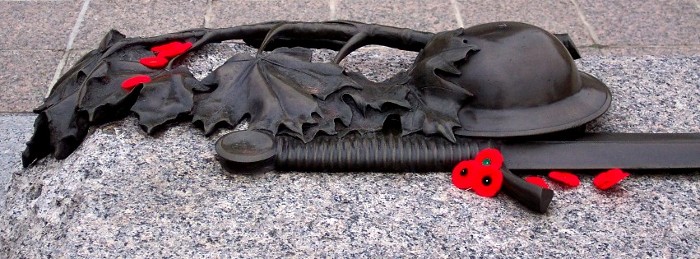
Rolls of Honour
As someone with an interest in regimental history, admittedly focused on my own Regiment, the topic of the Roll of Honour occasionally comes up. One aspect that provokes both strident opinions in some, and careful reflection in others, is the question of how to decide what names belong on a given Roll of Honour. The sticky point, though seldom expressed as such, is a perception that naming a soldier on a Roll of Honour is somehow a binding act of "ownership" and that this should be an exclusive right.
Nothing could be further from the truth. We all share a responsibility, as a nation, to honour our fallen. We strengthen the bonds of that responsibility with every addition of a soldier to our many Rolls of Honour that commemorate their service and sacrifice, as long as we understand (and, as needed, identify) what connects them to our regiment.
Opportunities for Change and Improvement
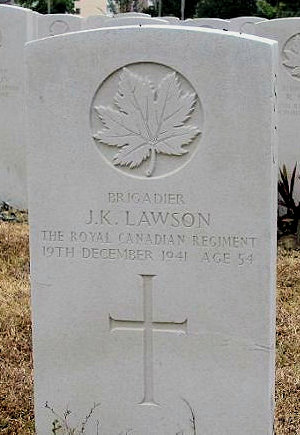 Allow me to describe one restrictive example. Within Volumes I and II of the regimental history of The Royal Canadian Regiment, annexes comprising the casualty lists of each of the Regiment's periods of wartime service. At first glance they appear to be comprehensive and have been accepted as such by many. But these lists were limited to those Royal Canadians who died while serving with the applicable overseas unit. Oddly, this excluded Brigadier John Kelburne Lawson who died commanding Canadian troops in Hong Kong. Brigadier Lawson served with The RCR from 1923. he had previously served in the Canadian Machine Gun Corps during the First World War, and was awarded the Military Cross. Lawson's gravestone in Hong Kong even identifies his regiment as The Royal Canadian Regiment.
Allow me to describe one restrictive example. Within Volumes I and II of the regimental history of The Royal Canadian Regiment, annexes comprising the casualty lists of each of the Regiment's periods of wartime service. At first glance they appear to be comprehensive and have been accepted as such by many. But these lists were limited to those Royal Canadians who died while serving with the applicable overseas unit. Oddly, this excluded Brigadier John Kelburne Lawson who died commanding Canadian troops in Hong Kong. Brigadier Lawson served with The RCR from 1923. he had previously served in the Canadian Machine Gun Corps during the First World War, and was awarded the Military Cross. Lawson's gravestone in Hong Kong even identifies his regiment as The Royal Canadian Regiment.
This selective approach to recording our regimental casualties has resulted in losing connections to others as well.
During the Second World War, Lieutenant John Blair Hunt landed in Sicily as The RCR's Intelligence Officer. Wounded in late 1943, he returned as a reinforcement to the PPCLI with whom he was killed two days later at San Leonardo on 14 Dec 1943. Regimental histories for both The RCR (Vol. 2, Stevens, 1967) and the PPCLI (Vol III, Stevens, 1957) agree in their texts that Lieut. Hunt had "been loaned by The Royal Canadian Regiment as a company commander two days before" when he was killed in action (quoted from PPCLI Vol III, p. 133). Despite this, Lieut. Hunt is officially recorded as a casualty of the PPCLI and was not recorded as a regimental casualty in the Regiment's Roll of Honour.
The choice of restrictive bounds in constructing any Regiment's Roll of Honour means many are forgotten by those who owe them a debt of Remembrance. Adding those who have any service connection to a Regiment to that Regiment's Roll of Honour does not detract from their entitlement to be included on other Rolls. We should be encouraging the development of expansive rolls, commemorating the many connections we have to our fallen, no matter who they went on to serve with after marching in our own ranks. We all share the burden of remembering their service, and commemorating their sacrifice.
"Once a Royal Canadian, always a Royal Canadian" is often quoted to suggest that once someone has served with The RCR, they are obliged to remember that service and always be proud of it. It is a sentiment expressed by many regiments, and it's an obligation that should be placed as much on the regiment as on the soldier.

Published Rolls; not always complete
The published Rolls of Honour for The Royal Canadian Regiment, and likely those of many units that have not re-examined them, were not complete. I began examining the Rolls of Honour when I was serving as the Regimental Adjutant, and was surprised by what I discovered in comparing the lists to the available information. (Updated versions can now be found on the Regiment's website.) The figures below show the scope of change.
| Published regimental history: | Revisited research: | An increase of: | |
| First World War | 774 | 818 | 44 (5.7%) |
| Second World War | 371 | 414 | 43 (11.6%) |
| Korean War | 96 | 148 | 51 (53.1%) |
How, you might ask, can the numbers change for the World Wars and Korea? The differences come with the readily available information in online databases such as the Canadian Virtual War Memorial and the Commonwealth War Graves Commission. Rolls researched and published in the 1930s and 1960s did not have the advantages of such readily accessible information, or the ability for researchers to search for names which had not previously been identified to regiments by the administration (in particular for soldiers who died of woulds or service related illnesses after repatriation and discharge from the military, but still within the date ranges for recognition).
Those numbers are not yet complete. The revisited Second World War list includes Brigadier Lawson, who lies under an RCR marked gravestone, but not yet Lieutenant Hunt, who is recorded officially as PPCLI. That requires a more open attitude to how to include names, and how to identify them; for example, by noting the unit they were serving in at time of death and their connection to the Regiment.
We can still build on this Roll in other directions. This applies not only for the modern era where soldiers under many cap badges were serving with the Regiment in Afghanistan, but also for past wars. As we improve our shared understanding of regimental history and lineage, we also develop and broaden our understanding of our responsibilities to commemorate. In doing so, we can find other soldiers who deserve to be remembered by our regiments too. We can take as our example the continuing work at the national level to add deserving names to the Books of Remembrance, the national Roll of Honour.
The Great War
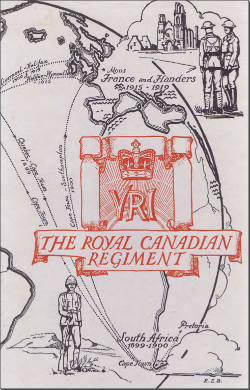 Not long ago, in my research on The Royal Canadian Regiment in the First World War, I revisited that Roll of Honour once again. In cross-referencing the wartime nominal roll that I had developed to Ted Wigney's CEF Roll of Honour, I identified another 39 officers, NCOs and soldiers of the First World War who served with The RCR in the field and later died while on the strength of other units. Some were RCR soldiers who had been posted to other units without a change of parent regiment. Others were initially soldiers of The RCR and later changed both units and badges. Still others spent periods with the Regiment for familiarization in the trenches or while awaiting commissioning, and still more were taken on the strength of The RCR only to be transferred again days or weeks later to another front line unit as the reinforcement system struggled to make up and balance losses. These too, were Royal Canadians, however briefly, and deserve to be remembered as such.
Not long ago, in my research on The Royal Canadian Regiment in the First World War, I revisited that Roll of Honour once again. In cross-referencing the wartime nominal roll that I had developed to Ted Wigney's CEF Roll of Honour, I identified another 39 officers, NCOs and soldiers of the First World War who served with The RCR in the field and later died while on the strength of other units. Some were RCR soldiers who had been posted to other units without a change of parent regiment. Others were initially soldiers of The RCR and later changed both units and badges. Still others spent periods with the Regiment for familiarization in the trenches or while awaiting commissioning, and still more were taken on the strength of The RCR only to be transferred again days or weeks later to another front line unit as the reinforcement system struggled to make up and balance losses. These too, were Royal Canadians, however briefly, and deserve to be remembered as such.
But the First World War also opens up the broadest scope for commemorating our fallen, once we consider our responsibilities to those units our regiments perpetuate. With perpetuation, we not only accepted the honours awarded to those units, but we also accepted the responsibility to remember their histories, their contributions, their service, and their sacrifice.
Continuing with The RCR for my examples, these are the perpetuated units of The RCR (admittedly, each of these lists needs more detailed work):
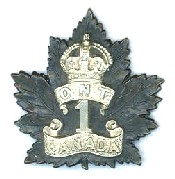 1st Canadian Infantry Battalion — about 6000 soldiers passed through the ranks of the 1st Cdn Inf Bn, the Commonwealth War Graves Commission Database lists 1430 casualties identified as 1st Cdn Inf Bn.
1st Canadian Infantry Battalion — about 6000 soldiers passed through the ranks of the 1st Cdn Inf Bn, the Commonwealth War Graves Commission Database lists 1430 casualties identified as 1st Cdn Inf Bn.
33rd Canadian Infantry Battalion — The sailing list for the 33rd Cdn Inf Bn includes 1499 officers, NCOs and soldiers. Of these, 385 are listed as casualties of the war, dying while serving with 40 different units. Another twelve 33rd Battalion casualties have also been identified.
71st Canadian Infantry Battalion — The sailing list for the 71st Cdn Inf Bn includes 1293 officers, NCOs and soldiers. Of these, 284 are listed as casualties of the war, dying while serving with 57 different units. Another seven 71st Battalion casualties have also been identified.
142nd Canadian Infantry Battalion — The sailing list for the 142nd Cdn Inf Bn includes 607 officers, NCOs and soldiers. Of these, 78 are listed as casualties of the war, dying while serving with 19 different units. Another five 142nd Battalion casualties have also been identified.
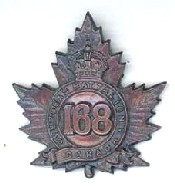 168th Canadian Infantry Battalion — The sailing list for the 168th Cdn Inf Bn includes 721 officers, NCOs and soldiers. Of these, 148 are listed as casualties of the war, dying while serving with 18 different units. One other 168th Battalion casualty has also been identified.
168th Canadian Infantry Battalion — The sailing list for the 168th Cdn Inf Bn includes 721 officers, NCOs and soldiers. Of these, 148 are listed as casualties of the war, dying while serving with 18 different units. One other 168th Battalion casualty has also been identified.
2nd Battalion, Canadian Machine Gun Corps — The website developed by Bett Payne commemorating the 6th Canadian M.G. Company and the 2nd Battalion, CMGC, identifies 141 casualties of this battalion after its formation. (This does not include the prior casualties of the four M.G. Companies that formed the 2nd Battalion, C.M.G.C.)
Fusiliers and Riflemen. The CWGC database also identifies seven soldiers of the 7th Fusiliers who are official casualties of the Great War. The data for the Second World War lists six soldiers of the Canadian Fusiliers and four from The Oxford Rifles. How many went on to die serving in the units those regiments' soldiers went to as reinforcements is unknown as of this writing.
Living Documents
The Rolls of Honour that we see, however familiar they may be to us, are not static lists. They can and should change as we find new names that that have connections to our regiments. We can evolve and improve our understanding of how names were selected for them in the past and revise how we select names for them now and in the future. The Rolls of Honour will grow as we open ourselves to the broadest acceptance of our responsibility to commemorate out nations' fallen soldiers.
As we approach the centennial of the First World War, the responsibilities of perpetuation become ever more important. While we may readily count the Battle Honours our regiments hold from those perpetuated units, and acknowledge the post war connections that perpetuation established, we must also understand that with those connection came the responsibility to honour their sacrifice.
Too restrictive an approach in developing Rolls of Honour can lead to overlooking thousands of soldiers who deserve to be remembered, by each of the regiments to which their service connects. No fallen soldier is diminished because more than one regiment remembers him.
Lest we Forget

